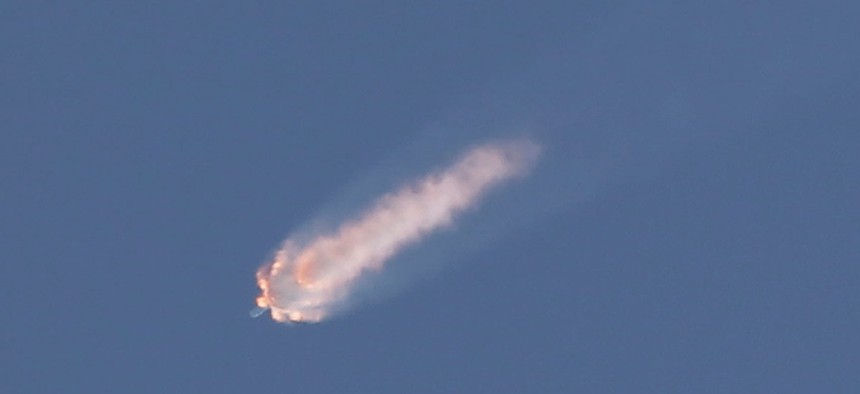
Moments after launch, CRS-7 went up in a puff a smoke. John Raoux/AP file photo
For the first time, NASA investigators said publicly that a design error was the initiating factor for the destruction of a SpaceX Falcon 9 rocket on a mission to the International Space Station in 2015.
A public summary of their report, released Monday (pdf), expands on SpaceX’s public explanation for the failure of the CRS-7 mission. The rocket company blamed a subcontractor that manufactured a steel strut which snapped during the flight, allowing a helium bottle to break loose and crash through a liquid oxygen tank, which burst, combusted and destroyed the vehicle. NASA says SpaceX should known that the strut was not suited for spaceflight, calling the decision to use it a “design error.”
“SpaceX chose to use an industrial grade (as opposed to aerospace grade) [precipitation-hardening stainless steel] cast part…in a critical load path under cryogenic conditions and strenuous flight environments,” the report says. “The implementation was done without adequate screening or testing of the industrial grade part, without regard to the manufacturer’s recommendations for a 4:1 factor of safety when using their industrial grade part in an application, and without proper modeling or adequate load testing of the part under predicted flight conditions.”
SpaceX CEO and lead designer Elon Musk told reporters after the failure that an individual strut was suspected to be below the manufacturer’s standard, describing a process that examined thousands of the parts and found a few dud struts. In its own report on the accident, SpaceX had noted that the strut was certified to handle 10,000 lbs of force, but failed when subject to just one-fifth of that stress.
Investigators did note that all the issues they identified were resolved when SpaceX launched another NASA payload in January 2016. Their inquiry was completed in December 2015; NASA said it released the summary more than two years later “to maintain historical data of the mishap.” SpaceX no longer makes this version of the Falcon 9, and has flown their rocket successfully 31 times since the accident, with one rocket destroyed during a fueling mishap in September 2016.
“NASA Launch Services Program’s independent review came to the same conclusion as SpaceX—that all credible causes for the anomaly were corrected or mitigated by SpaceX before the company returned to flight,” a SpaceX spokesperson told Quartz. “We appreciate NASA’s insight and continued partnership, and we look forward to next month’s launch of a flight-proven Dragon for the company’s fourteenth resupply mission to the International Space Station (CRS-14) as well as the launch of the Transiting Exoplanet Survey Satellite (TESS) for NASA.”
Rumors that NASA disagreed with SpaceX’s assessment were rampant after the incident, and a 2016 Inspector General report referenced possible additional causes, like poor installation practices, that could be behind its failure. At the time, NASA demanded a large reorganization at SpaceX to adopt more reliability and safety controls in its hardware supply chain to ensure that accidents like this don’t happen again. SpaceX also ate the cost of the failure, and re-jiggered its program to provide additional flights and services to NASA.
One key to SpaceX’s ability to deliver rockets cheaply has been its willingness to use “off the shelf” components instead of paying inflated sums for space-certified parts from government contractors, replacing old serial bus cables with modern ethernet lines, or using toilet stall handles as latches on spacecraft storage lockers. That strategy may have been pushed too far before the CRS-7 failure.
SpaceX is expected to launch its next mission, for satellite operator Iridium, from Vandenberg Air Force Base on March 29.
NEXT STORY: Who's Running NASA?







